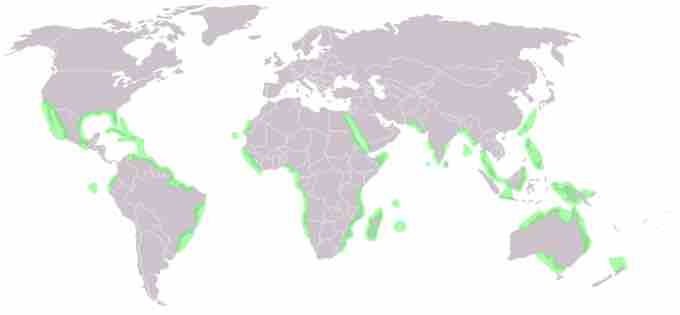Mangroves
A Mangrove swamp is a distinct saline woodland or shrubland habitat formed by mangrove trees. They are characterized by depositional coastal environments, where fine sediments (often with high organic content) collect in areas protected from high-energy wave action. The saline conditions tolerated by various mangrove species range from brackish water, through pure seawater (3 to 4 %), to water concentrated by evaporation to over twice the salinity of ocean seawater (up to 9 %).
Mangroves are shrubs or small trees that grow in coastal saline or brackish water. The term is also used for tropical coastal vegetation consisting of such species. Mangroves occur worldwide in the tropics and subtropics, mainly between N and S. In the year 2000, the area of mangroves was 53,190 square miles (137,760 km²), spanning 118 countries and territories.
Mangrove trees bordering a tidal estuary in Everglades National Park, Florida, USA
Mangroves are salt tolerant trees, also called halophytes, and are adapted to life in harsh coastal conditions. They contain a complex salt filtration system and complex root system to cope with salt water immersion and wave action. They are adapted to the low oxygen (anoxic) conditions of waterlogged mud.
Mangrove swamps are found in tropical and subtropical tidal areas. Areas where mangal occurs include estuaries and marine shorelines.

World map of mangrove distribution
The intertidal existence to which these trees are adapted represents the major limitation to the number of species able to thrive in their habitat. High tide brings in salt water, and when the tide recedes, solar evaporation of the seawater in the soil leads to further increases in salinity. The return of tide can flush out these soils, bringing them back to salinity levels comparable to that of seawater.
At low tide, organisms are also exposed to increases in temperature and desiccation, and are then cooled and flooded by the tide. Thus, for a plant to survive in this environment, it must tolerate broad ranges of salinity, temperature, and moisture, as well as a number of other key environmental factors — thus only a select few species make up the mangrove tree community.
Protective Value Mangrove Swamps
Mangrove swamps protect coastal areas from erosion, storm surge (especially during hurricanes), and tsunamis. The mangroves' massive root systems are efficient at dissipating wave energy. Likewise, they slow down tidal water enough so its sediment is deposited as the tide comes in, leaving all except fine particles when the tide ebbs. In this way, mangroves build their own environments. Because of the uniqueness of mangrove ecosystems and the protection against erosion they provide, they are often the object of conservation programs, including national biodiversity action plans.
The protective value of mangrove swamps is sometimes overstated. Wave energy is typically low in areas where mangroves grow, so their effect on erosion can only be measured over long periods. Their capacity to limit high-energy wave erosion is limited to events such as storm surges and tsunamis. Erosion often occurs on the outer sides of bends in river channels that wind through mangroves, while new stands of mangroves are appearing on the inner sides where sediment is accruing.